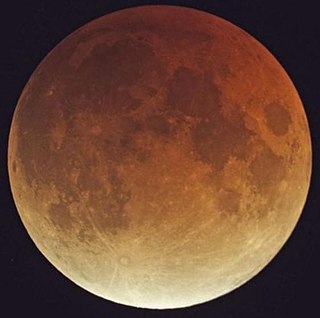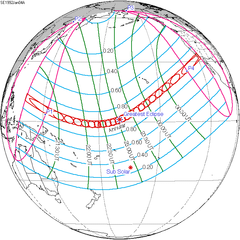
A total lunar eclipse occurred on February 20 and February 21, 2008. It was visible in the eastern evening sky on February 20 for all of North and South America, and on February 21 in the predawn western sky from most of Africa and Europe. Greatest Eclipse occurring on Thursday, February 21, 2008, at 03:26:03 UTC, totality lasting 49 minutes and 45.6 seconds.

A total lunar eclipse took place on Friday 16 May 2003, the first of two total lunar eclipses in 2003, the other being on 9 November 2003. A shallow total eclipse saw the Moon in relative darkness for 52 minutes and 3.1 seconds. The Moon was 12.938% of its diameter into the Earth's umbral shadow, and should have been significantly darkened. The partial eclipse lasted for 3 hours, 15 minutes and 3.1 seconds in total. Occurring only 0.5 days after perigee, the Moon's apparent diameter was 6.2% larger than average. At greatest eclipse the Moon was only 357,693 km from the Earth, making it a Super Full Moon.

A penumbral lunar eclipse took place on Sunday 30 December 2001, the last of three lunar eclipses in 2001. At maximum eclipse, 89.477% of the Moon's disc was partially shaded by the Earth, which caused a slight shadow gradient across its disc; this subtle effect may have been visible to careful observers. No part of the Moon was in complete shadow. The eclipse lasted 4 hours, 4 minutes and 17.7 seconds overall. This lunar eclipse followed the Annular Solar Eclipse on 14 December 2001.

A partial lunar eclipse took place on Thursday 5 July 2001, the second of three lunar eclipses in 2001. The Earth's shadow on the moon was clearly visible in this eclipse, with 49.614% of the Moon in shadow; the partial eclipse lasted for 2 hours, 40 minutes and 0.5 seconds. Occurring only 3.9 days before apogee, the Moon’s apparent diameter was 5.021% smaller than average.

A total lunar eclipse took place at the Moon's descending node of the orbit on Tuesday, September 16, 1997, the second of two lunar eclipses in 1997. A shallow total eclipse saw the Moon in relative darkness for 1 hour, 1 minute and 30.8 seconds. The Moon was 19.094% of its diameter into the Earth's umbral shadow, and should have been significantly darkened. The partial eclipse lasted for 3 hours, 16 minutes and 28.2 seconds in total. The penumbral eclipse lasted for 5 hours, 8 minutes and 20.1 seconds. The partial eclipse lasted for 3 hours, 16 minutes and 28.2 seconds. The total eclipse lasted for 1 hour, 1 minute and 30.8 seconds. Maximum eclipse was at 18:46:39.1 UTC. The moon's apparent diameter was extremely large because occurred only 3 hours and 21 minutes past perigee. The Moon was only 356,986 km of the Earth at greatest eclipse.

A total lunar eclipse will take place on July 7, 2047. It will last 1 hour 40 minutes and 49 seconds and will plunge the full Moon into deep darkness, as it passes right through the centre of the Earth's umbral shadow. While the visual effect of a total eclipse is variable, the Moon may be stained a deep orange or red colour at maximum eclipse. This will be a great spectacle for everyone who sees it. The partial eclipse will last for 3 hours and 39 minutes in total.
A total lunar eclipse took place on Saturday, January 9 and Sunday, January 10, 1982, the first of three lunar eclipses in 1982. The Moon was plunged into darkness for 1 hour and 17 minutes 39.5 seconds, in a deep total eclipse which saw the Moon 33.103% of its diameter inside the Earth's umbral shadow. The visual effect of this depends on the state of the Earth's atmosphere, but the Moon may have been stained a deep red colour. The partial eclipse lasted for 3 hours and 24 minutes in total.
A total lunar eclipse took place on Thursday, April 24, 1986, the first of two total lunar eclipses in 1986, the second being on October 17, 1986. The Moon was plunged into darkness for 1 hour, 3 minutes and 34.8 seconds, in a deep total eclipse which saw the Moon 20.217% of its diameter inside the Earth's umbral shadow. The visual effect of this depends on the state of the Earth's atmosphere, but the Moon may have been stained a deep red colour. The partial eclipse lasted for 3 hours, 18 minutes and 46.8 seconds in total. The Moon was just 1.2 days before perigee, making it 5.3% larger than average.
A penumbral lunar eclipse took place on Thursday, March 3, 1988, the first of two lunar eclipses in 1988, the second being on August 27, 1988. Earlier sources compute this as a 0.3% partial eclipse lasting under 14 minutes, and newest calculations list it as a penumbral eclipse that never enters the umbral shadow. In a rare total penumbral eclipse, the entire Moon was partially shaded by the Earth, and the shading across the Moon should have been quite visible at maximum eclipse. The penumbral phase lasted for 4 hours, 53 minutes and 50.6 seconds in all, though for most of it, the eclipse was extremely difficult or impossible to see. The Moon was 2.2 days after apogee, making it 6.1% smaller than average.
A penumbral lunar eclipse took place on Tuesday, January 20, 1981, the first of two lunar eclipses in 1981. In a rare total penumbral eclipse, the entire Moon was partially shaded by the Earth, and the shading across the Moon should have been quite visible at maximum eclipse. The penumbral phase lasted for 4 hours and 24 minutes in all, though for most of it, the eclipse was extremely difficult or impossible to see. The moon's apparent diameter was larger because the eclipse occurred 5.2 days after perigee.
A total lunar eclipse took place on Friday, November 29, 1974, the second of two lunar eclipses in 1974. The Moon was plunged into darkness for 1 hour, 15 minutes and 45 seconds, in a deep total eclipse which saw the Moon 28.961% of its diameter inside the Earth's umbral shadow. The visual effect of this depends on the state of the Earth's atmosphere, but the Moon may have been stained a deep red colour. The partial eclipse lasted for 3 hours, 28 minutes and 58.7 seconds in total. The penumbral eclipse lasted for 5 hours, 33 minutes and 11.6 seconds. The partial eclipse lasted for 3 hours, 28 minutes and 58.7 seconds. The total eclipse lasted for 1 hour, 15 minutes and 45 seconds. Occurring only 3.6 days before perigee, the Moon's apparent diameter was 1.4% larger than average.

A partial lunar eclipse occurred on 19 November 2021. The eclipse occurred towards a micromoon. This was the longest partial lunar eclipse since 18 February 1440, and the longest until 8 February, 2669; however, many eclipses, including the November 2022 lunar eclipse, have a longer period of umbral contact at next to 3 hours 40 minutes. It was often referred to as a "Beaver Blood Moon" although not technically fulfilling the criteria for a true blood moon (totality).
A penumbral lunar eclipse took place on Tuesday, September 27, 1977, the second of two lunar eclipses in 1977. At maximum eclipse, 90.076% of the Moon's disc was partially shaded by the Earth, which caused a slight shadow gradient across its disc; this subtle effect may have been visible to careful observers. No part of the Moon was in complete shadow. The eclipse lasted 4 hours, 17 minutes and 35.5 seconds overall. Occurring 6.2 days before apogee, the Moon's apparent diameter was 2.2% smaller than average.
A total lunar eclipse took place on Saturday, September 16, 1978, the second of two total lunar eclipses in 1978. The Moon was plunged into darkness for 1 hour, 18 minutes and 39 seconds, in a deep total eclipse which saw the Moon 32.683% of its diameter inside the Earth's umbral shadow. The visual effect of this depends on the state of the Earth's atmosphere, but the Moon may have been stained a deep red colour. The partial eclipse lasted for 3 hours, 27 minutes and 11.6 seconds in total.
A partial lunar eclipse took place on Tuesday, March 13, 1979, the first of two lunar eclipses in 1979. The Moon was strikingly shadowed in this deep partial eclipse which lasted 3 hours, 17 minutes and 40.6 seconds, with 85.377% of the Moon in darkness at maximum.
A penumbral lunar eclipse took place on Saturday, March 1, 1980, the first of three penumbral lunar eclipses in 1980. This subtle penumbral eclipse may have been visible to a skilled observer at maximum eclipse. 65.455% of the Moon's disc was partially shaded by the Earth, which caused a gentle shadow gradient across its disc at maximum; the eclipse as a whole lasted 3 hours, 58 minutes and 33.3 seconds.
A partial lunar eclipse took place on Thursday, May 13, 1976, the first of two lunar eclipses in 1976, the second being a penumbral lunar eclipse on November 6, 1976. At maximum eclipse, a small bite out of the Moon should have been visible. The eclipse lasted for 1 hour, 15 minutes and 23.8 seconds, with just 12.17% of the Moon in shadow at maximum. Occurring only 1.1 days after perigee, the Moon's apparent diameter 5.4% larger than average.
A penumbral lunar eclipse took place on Saturday, November 6, 1976, the second of two lunar eclipses in 1976, the first being on May 13. This subtle penumbral eclipse may have been visible to a skilled observer at maximum eclipse. 83.827% of the Moon's disc was partially shaded by the Earth, which caused a gentle shadow gradient across its disc at maximum; the eclipse as a whole lasted 4 hours, 25 minutes and 52.1 seconds. Occurring only 0.3 days after apogee, the Moon's apparent diameter was 6.5% smaller than average.
A total lunar eclipse took place on Sunday, January 30, 1972, the first of two lunar eclipses in 1972. The moon entered the Earth's penumbral shadow at 30 January 1972 08:03:12.5 UTC and exited at 30 January 1972 13:43:37.9 UTC. The moon entered the Earth's umbral shadow at 30 January 1972 09:11:38.4 UTC and exited at 30 January 1972 12:35:03.1 UTC. Totality lasted 34 minutes, 47.7 seconds, between 10:35:57.4 UTC and 11:10:45.1 UTC. The moon was 6.6 days before apogee, making it 1.6% smaller than average, only 0.2% larger than the July 1972's lunar eclipse.

A total lunar eclipse took place on Sunday, July 26, 1953.




































